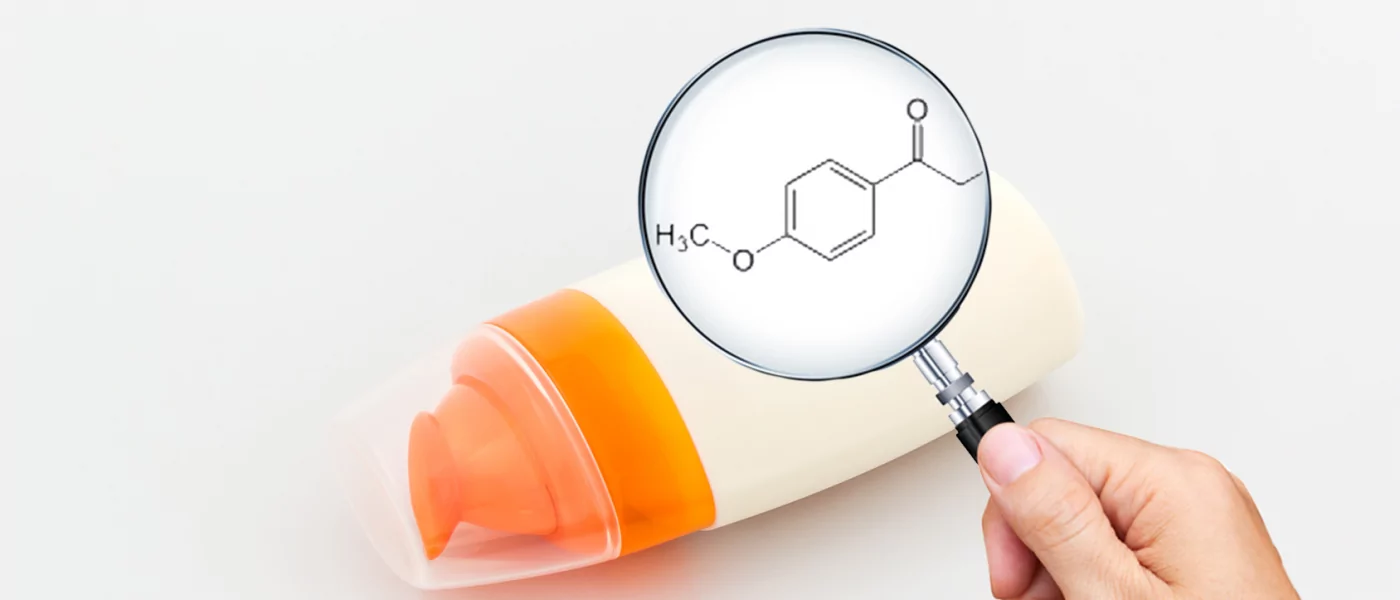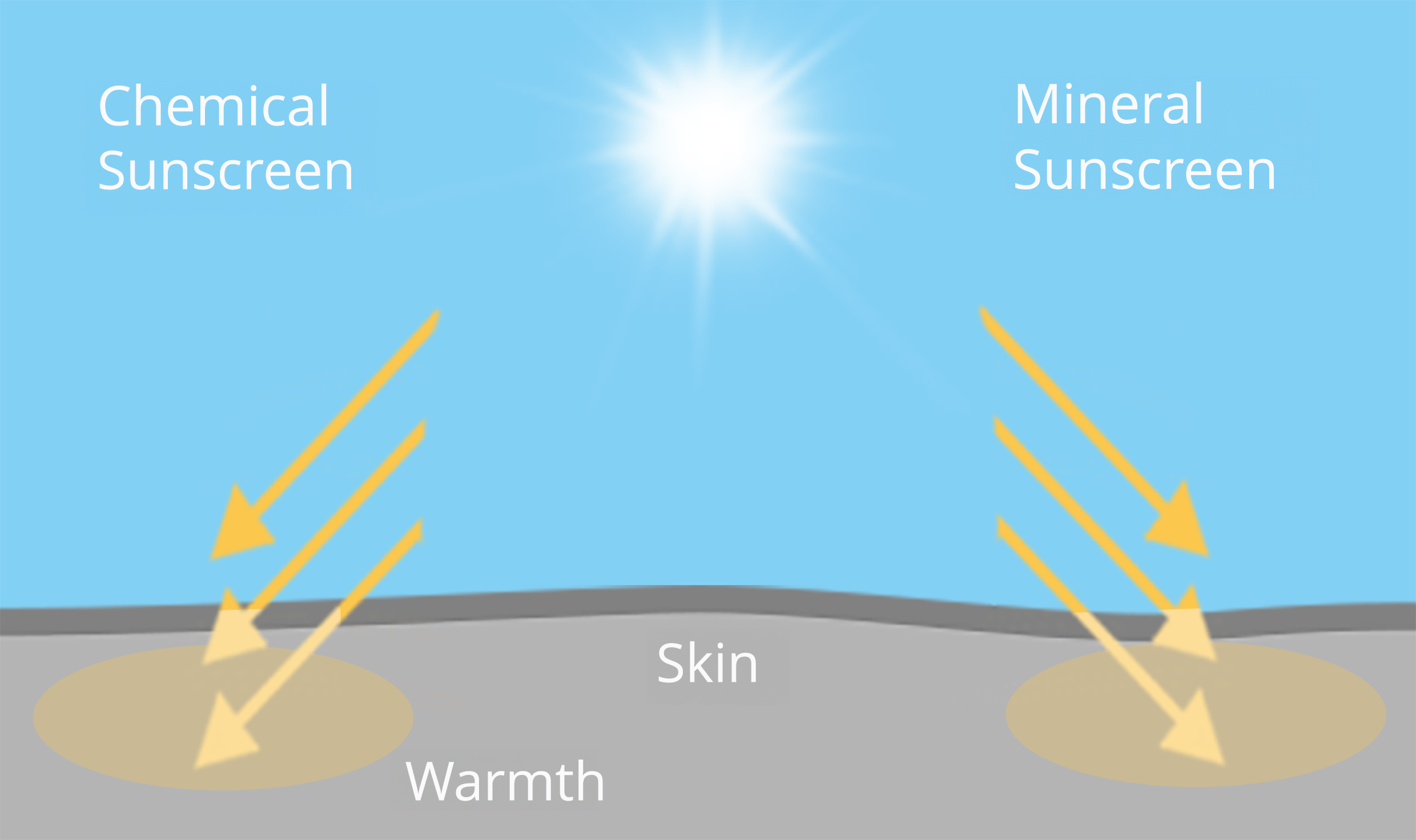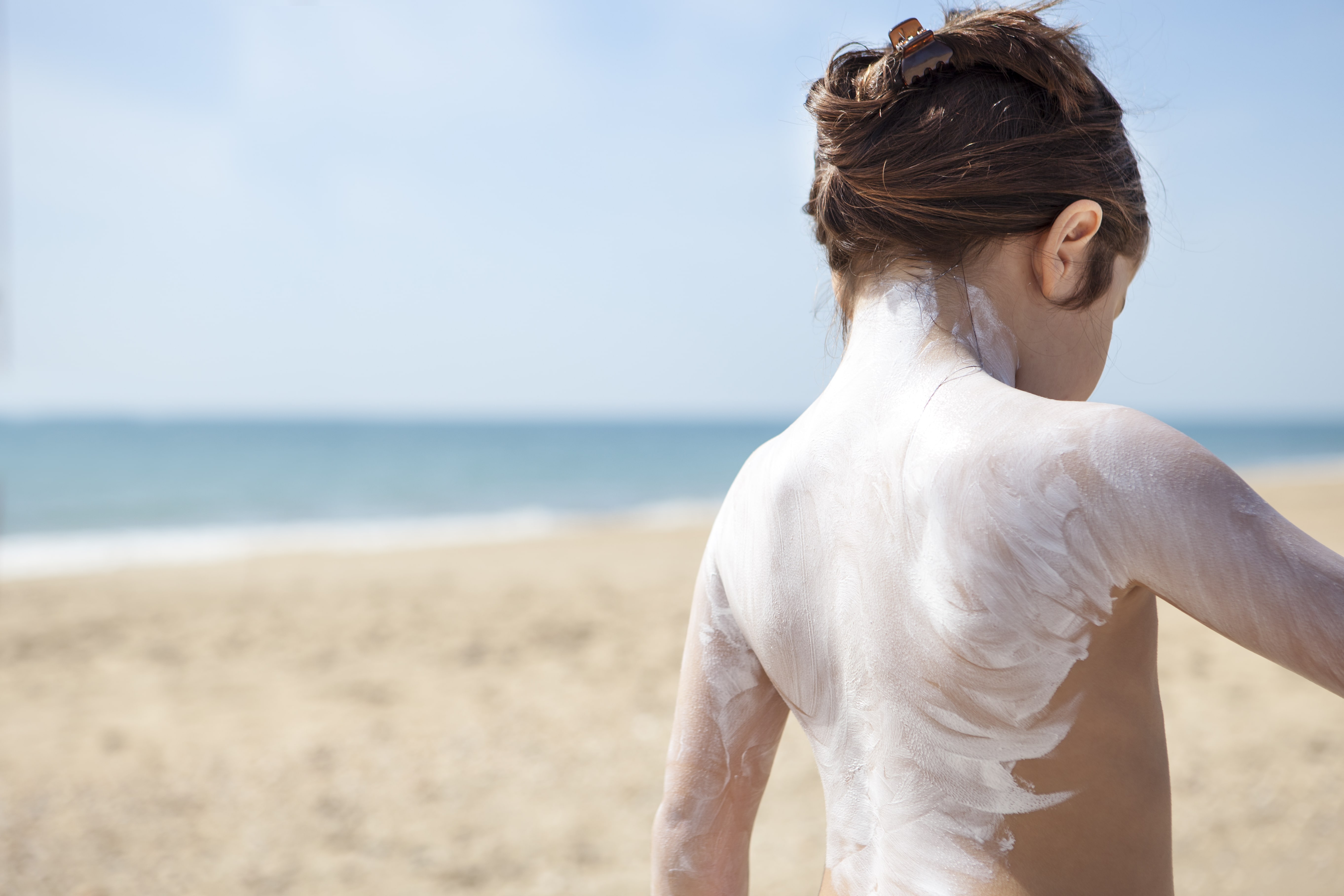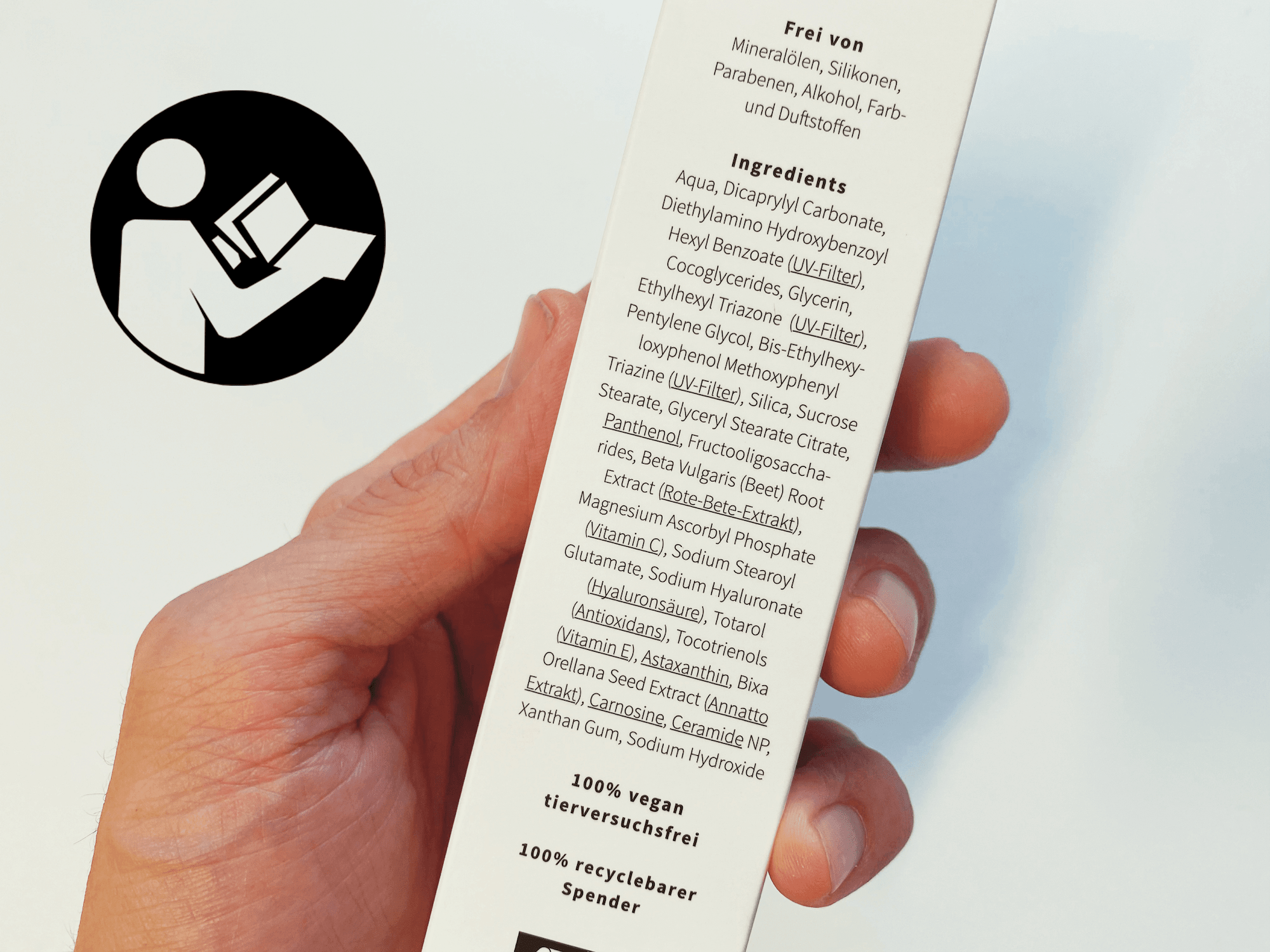Sunscreen Overview
UV Filters in Sunscreens: Which Ones Are Truly Effective?
The quality of a sunscreen primarily depends on the UV filter it employs. These substances provide sun protection by preventing UV radiation from damaging our skin. Unfortunately, it can be challenging to navigate this landscape as UV filters often have complex chemical names and varying levels of compatibility. Here, you'll discover which sun protection filters you can trust.

Nico Beyer
October 2024

Table of Contents
What makes a good UV filter?
Sunscreen: What to Look for When Buying
Important: Protection against UVA and UVB radiation
Additional rays: Protection against Infrared, Blue Light?
Is visible light harmful?
Chemical, organic, or mineral? Types of UV filters
Mineral filters: safe and well-tolerated
Mineral filters in nanoparticle size: harmful or not?
What is better: Chemical or mineral filters?
Are well-tolerated chemical UV filters better?
Natural UV filters – do they exist?
Are organic UV filters natural?
Antioxidants and oils as natural UV filters?
Which chemical UV filters are safe?
Diese Liste enthält alle verträglichen UV-Filter ohne schädliche Nebenwirkungen:
UV Filters We Avoid
These UV filters penetrate the skin:
UV Filters that Trigger Allergies:
UV Filters Suspected of Disrupting Metabolic Processes:
UV Filters that are Not Photostable:
UV Filters Containing Microplastics:
Chemical-Mineral Hybrid Forms with Nanoparticles:
Beyer & Söhne Sunscreen:
Which Sunscreen is Coral-Friendly?
Conclusion
Sunscreen: All UV Filters in the Test
This article was last updated in August 2019
Sources and Studies
If you want to jump straight to the overview
CLICK HERE >
What makes a good UV filter?
Not all UV filters are created equal. Some UV filters break down under UV radiation, making them non-photostable. This results in diminished protective effects, and the breakdown products can irritate the skin.
Certain chemical sunscreens have the potential to trigger allergies, often misinterpreted as sun allergy. Learn how to identify sun allergies in this article.
It is particularly concerning when UV filters enter the bloodstream, posing a risk of disrupting the body's metabolic processes. Therefore, careful consideration is crucial when it comes to UV filters.
A good UV filter should encompass these qualities:
Not penetrate the skin
Not cause allergies
Be photostable, i.e., not degrade in the sun
Have no adverse effects on the body's metabolism
Sunscreen: What to Look for When Buying
UV filters are indicated on the sunscreen packaging along with other ingredients. However, manufacturers often combine several UV filters in one product.
Moreover, many filter substances hide behind complex and hard-to-remember names (see the list at the end). Therefore, a closer look is necessary.
While it may be tedious, a thorough examination of the ingredient list is worthwhile. In the United States, UV filters are listed separately on the packaging, making them easier to identify. This practice would also simplify recognition in Germany.
Important: Protection against UVA and UVB radiation
Additionally, the combination of filters should protect against both UVA and UVB rays. UVB rays from the sun cause sunburn, while UVA rays silently contribute to skin aging.
The indicated sun protection factor (SPF) only refers to UVB radiation. Therefore, it is crucial to ensure that the packaging also features the UVA seal. This is the only way to be certain that the product provides protection against both types of rays.
The seal is present when the UVA protection is 1/3 of the UVB protection. For example, with an SPF of 30, the UVA factor must be at least 10. Incidentally, the UVA factor is also referred to as PPD, which stands for
Persistent Pigment Darkening
. This relates to protection against pigmentation, i.e., skin tanning.
From a dermatological perspective, the higher the UVA protection, the better. If in doubt, inquire with your manufacturer.

UV filters should also protect against UVA radiation. This seal should be present on every sunscreen.
Additional rays: Protection against Infrared, Blue Light?
Infrared radiation contributes to the warmth of the sun. Conventional filtering substances do not protect against these rays. Protection against infrared radiation is provided by vitamins and antioxidants. A sun protection product should include specific vitamins to ensure better defense against infrared rays.
These vitamins protect against infrared radiation
Studies have shown that Vitamin E is effective against infrared radiation. Vitamin C can also provide protection against infrared radiation. Coenzyme Q10 (Ubiquinone) is familiar to many, but few know that it also protects against infrared radiation. You can find the relevant study in the sources.
What protects against Blue Light?
Blue Light is the radiation emitted by screens and mobile devices. Conventional UV filters do not provide protection against it. It is likely that Astaxanthin, a potent antioxidant and carotenoid, can absorb Blue Light radiation. However, we do not recommend panicking and suggest focusing primarily on UV radiation.
Our Dayshade Sunscreen provides good protection against Blue Light. We have tested this.
Is visible light harmful?
In simplified terms, visible light appears to have many positive effects on our skin health. Visible light is divided into different frequency ranges perceived as colors, such as blue, red, yellow. Blue Light is also a part of visible light.
Certain wavelengths from the red and yellow light spectrum are used in dermatology as lasers, for example, to treat redness, visible vessels, and acne. Blue light can also have positive effects and is used in dermatology to treat precancerous skin lesions, acne, and psoriasis. On the other hand, blue light seems to favor the formation of free radicals, which can have long-term negative consequences. It is associated with hyperpigmentation.
So, what is important for sun protection? Broad-spectrum protection with high UVA protection is the most important. After that, we are concerned about antioxidants that also protect against the harmful part of visible light, and there is also tested Blue Light protection. If that is ensured, there is absolutely no need to worry.
Chemical, organic, or mineral? Types of UV filters
1.
Chemical filters
(also called organic filters): These substances absorb UV radiation on the skin and convert it into heat.
2.
Mineral filters
(also called physical or inorganic filters): These are small particles, for example, zinc oxide or titanium dioxide. These particles also absorb UV radiation. The mechanism of action is quite similar to chemical filters.
By the way, it is a widespread myth that mineral filters mainly reflect UV radiation. In reality, reflection accounts for only a very small part of the protective effect. A large portion of the radiation is absorbed, similar to chemical filters.
Both filters have advantages and disadvantages. In the next paragraph, we will take a closer look at mineral filters. After that, we will address the question of whether chemical or mineral UV filters are better.

Chemical and mineral UV filters absorb UV radiation and convert it into heat.
Mineral filters: safe and well-tolerated
Mineral filters such as
titanium dioxide
or
zinc oxide
(INCI:
Titanium Dioxide, Zinc Oxide
) are generally well-tolerated. They have the advantage of not breaking down and not triggering allergic reactions. By the way, certified natural cosmetics must always rely on mineral filters.
However, these filters are not as pleasant to use as the chemical alternatives. The small particles often leave a white residue on the skin and are difficult to remove.

Mineral sunscreens often leave a thick white layer.
Mineral filters in nanoparticle size: harmful or not?
Mineral particles in nanoparticle size provide a solution. These particles are extremely tiny and therefore spread more easily on the skin. However, there has been recent debate about these small particles. It is suspected that the particles are so small that they can penetrate the body, posing a potential risk to the organism.
Whether nanoparticles penetrate the skin is not conclusively clarified according to current studies. In this article, we delve into the question of how harmful nanoparticles in sunscreens really are.
For those who want to be absolutely sure, avoiding nanoparticles is advisable. In our opinion, this is especially true for specific children's and baby sunscreens. Baby skin is so delicate that one should not take any risks.
By the way, all particles in nanoparticle size must be labeled with the word "Nano" in the ingredients list (always in parentheses after the respective filter).
What is better: Chemical or mineral filters?
While mineral filters are always well-tolerated, careful consideration is needed for chemical UV filters.
Taking a look at the ingredient list can be worthwhile. Because a sunscreen with compatible chemical filters is just as safe as a mineral sunscreen.
There are even some advantages. Modern chemical filters are much easier to remove from the skin's surface since they do not penetrate the skin. Mineral filters linger longer on the skin and can accumulate in our stratum corneum. This leads to mineral sun protection products potentially drying out the skin.
Are well-tolerated chemical UV filters better?
After in-depth exploration of the UV filters used, we now believe that sunscreens with the right chemical filters are superior. However, it also remains a matter of personal philosophy. Ultimately, it depends on what makes you feel most comfortable.
Note: There are many chemical sunscreen filters with undesirable side effects. Unfortunately, these are also the most commonly used filter substances, such as
Octocrylene
.
By the way, a new study from 2021 reveals that
Octocrylene
breaks down over time, decomposing into harmful substances. Therefore, it's advisable not to save a sunscreen with
Octocrylene
for the next summer.
Natural UV filters – do they exist?
We answer this question with a clear "yes and no." Mineral filters could be considered natural UV filters. However, they have dermatological drawbacks (drying out the skin).
Even in our ecosystem, tiny zinc oxide and titanium particles don't really belong. So, they are not truly natural.
Are organic UV filters natural?
Chemical UV filters are also called organic filters. But does that make them natural?
Not really. While they are organic compounds, they are substances that do not naturally occur in nature. Some have side effects.
Antioxidants and oils as natural UV filters?
Many antioxidants, such as
Vitamin E
and
Vitamin C
, help the skin protect itself against UV radiation. Plant-based substances like
green tea
,
resveratrol
, or
astaxanthin
also safeguard our skin, providing natural sun protection.
But beware: the natural sun protection factor is very low. No one should rely solely on natural substances. We recommend always using "real" UV filters as well.
Studies show: 80% of visible skin aging is triggered by UV radiation. However, UV filters only combat 55% of the resulting free radicals. Therefore, it makes sense to use a sunscreen with antioxidants or to apply a serum with antioxidants additionally to protect the skin even better. We recommend our Skin Gel+ or our Vitamin C Booster with 15% pure Vitamin C.

Checking the ingredients is worthwhile. Find safe UV filters with the help of our list.
Which chemical UV filters are safe?
There are now several chemical UV filters that provide effective protection against UV radiation while being well-tolerated. These UV filters are currently considered safe based on research findings. They have low allergenic potential, and studies have not shown any hormonal effects. All the filters listed here are also photostable.
Diese Liste enthält alle verträglichen UV-Filter ohne schädliche Nebenwirkungen:
Bis-Ethylhexyloxyphenol Methoxyphenyl Triazine
(Tinosorb S)
Drometrizole Trisiloxane
(Meroxyl XL)
Terephthalylidene Dicamphor Sulfonic Acid
(Mexoryl SX)
Ethylhexyl Triazone
(Uvinul T 150)
Butyl Methoxydibenzoylmethane
(Avobenzone) (This is a special case. This filter is not photostable when used alone, but it is now always stabilized by other filters, so it is appropriate to include it on the positive list.)
Diethylamino Hydroxybenzoyl Hexyl Benzoate
(Uvinul A Plus)
Diethylhexyl Butamido Triazone
(Iscotrizinol)
Phenylbenzimidazole Sulfonic Acid
(Enzulisol)
Phenylene Bis-Diphenyltriazine
(introduced to the market in 2019)
Methoxypropylamino Cyclohexenylidene Ethoxyethylcyanoacetate
(Mexoryl 400, new to the market)
UV Filters We Avoid
All common UV filters have been classified as "safe" on the positive list of the Cosmetics Regulation. However, new studies are continually being published, and we are not focused on the "average skin" but rather on our own skin and that of our family.
All common UV filters are listed as "safe" on the regulatory positive list for cosmetics. Yet, with new studies frequently emerging, our focus isn't on "average skin" but rather on our own and our family’s. This is why we choose to avoid the following UV filters.
These UV filters penetrate the skin:
We firmly believe that chemical UV filters have no place inside the body and should not accumulate there. Various studies help us determine whether the skin allows these substances to pass through.
Regularly, studies examine the blood or breast milk of participants for specific chemicals. If UV filters are detected, it indicates they have somehow entered the body.
Furthermore, laboratory tests investigate the penetration rate through the skin. For the UV filter Benzophenone-3, for instance, a penetration rate of over one percent was observed. Other UV filters that do not pass this test include:
Benzophenone-3, Benzophenone-4, Benzophenone-5, 4-Methylbenzylidene Camphor, Homosalate, Octocrylene, Octyl Methoxycinnamate
UV Filters that Trigger Allergies:
There are reports about some UV filters causing allergic reactions. Interestingly, this could also be the cause of a supposed sun allergy. We recommend avoiding the potential allergens:
Benzophenone-3, Benzophenone-4, Benzophenone-5, Ethylhexyl Dimethyl PABA, Homosalate, Octocrylene
UV Filters Suspected of Disrupting Metabolic Processes:
This can occur when UV filters resemble our hormones. In such cases, they may interfere with various metabolic processes or potentially promote tumors. Why use these substances when better options exist? We abstain from:
Benzophenone-3, Benzophenone-4, Benzophenone-5, 4-Methylbenzylidene Camphor, Isoamyl Methoxycinnamate, Homosalate, Octocrylene, Octyl Methoxycinnamate
UV Filters that are Not Photostable:
A substance meant to protect us from the sun should not break down under sunlight. While there are ways to stabilize these UV filters with other ingredients, caution is still advised with:
Octyl Methoxycinnamate
UV Filters Containing Microplastics:
Tinosorb S is a safe UV filter that we recommend. However, there is also the new filter
Tinosorb S Lite Aqua
(INCI: B
is-Ethylhexyloxyphenol Methoxyphenyl Triazine, Acrylates/C12-22 Alkyl Methacrylate Copolymer
). In this case, oil-soluble filters have been encapsulated with microplastics to create lighter textures. For ecological reasons, we advise against using microplastics.
Chemical-Mineral Hybrid Forms with Nanoparticles:
The filters
Tinosorb M
and
Tinosorb A2B
(INCI:
Methylene Bis-Benzotriazolyl Tetramethylbutylphenol (Nano)
and
Tris-Biphenyl Triazine (Nano)
) are innovative hybrid forms of filters, combining both chemical and mineral components. Since these filters incorporate nanoparticles, we cannot recommend them without reservations.
Beyer & Söhne Sunscreen:
We now offer two sunscreen products ourselves. Naturally, we only use UV filters that we can endorse:
Dayshade Cream with SPF 30:
A daily care product with high UVA protection, Astaxanthin, and additional antioxidants like Vitamin C.
Dayshade Fluid with SPF 50:
A lightweight oil-fluid with high UV protection, Astaxanthin, and an exceptionally effective form of Vitamin E.
PLATZHALTER PRODUKTE NEBENEINANDER
Which Sunscreen is Coral-Friendly?
Some UV filters can harm coral reefs. The filters currently under scrutiny are the "3 Os":
Oxybenzone
,
Octocrylene
, and
Octinoxate
.
The use of
Oxybenzone
and
Octinoxate
is even banned in Hawaii.
Octocrylene
is found in most products on the German market, often in high concentrations. We recommend avoiding these filters.
Additionally, there's a new UV filter containing microplastics: Tinosorb S Lite Aqua. Concerning the protection of our oceans, we advise against using this filter.
In the 'Reef Safe' discussion, there's uncertainty, as not all filters have been thoroughly examined. The prevailing opinion suggests that mineral filters like Zinc Oxide and Titanium Dioxide are reef-friendly, although there are dissenting views. What we can assert confidently is that the safe UV filters from our list also minimize the risk to our oceans.
One thing is clear: the most ocean-friendly approach is to cover your body with UV protection shirts.

When swimming, sunscreen gets into our oceans. The environmental impact of UV filters is not conclusively established.
Conclusion
Navigating the multitude of UV filters is challenging, especially as sunscreens often combine several of them. However, a discerning eye can take a significant step towards compatible sun protection.
For those who wish to avoid chemicals, opting for mineral filters like Zinc Oxide and Titanium Dioxide is advisable. Nonetheless, there are also chemical alternatives that are equally safe and may even offer advantages.
In the following list, you'll find all common UV filters. Nothing should hinder your safe sunbathing.
By the way, our extensive sunscreen test provides additional criteria for compatible sun protection. For instance, it is advisable to steer clear of fragrances.
Sunscreen: All UV Filters in the Test
| INCI | Recommendation | UV filter | Possible side effects | Alternative names |
|---|---|---|---|---|
| Zinc oxide | Yes | mineral | - | - |
| Zinc oxide, along with titanium dioxide, is one of the two physical UV filters. Physical filters, unlike chemical UV filters, are gentler and more nourishing to our skin. This means they are more suitable for sensitive skin, rosacea, eczema, and allergies. They reflect the UV rays, thus protecting the skin from damage. Zinc oxide provides protection against both UVA and UVB rays (broad-spectrum protection). | ||||
| Tris-Biphenyl Triazine (nano) | No | chemical and mineral | nanoparticles | Tinosorb A2B |
| Tinosorb A2B is a broad-spectrum filter known for its high water resistance. However, due to its nanoparticle size, we cannot recommend it without reservation. | ||||
| Titanium dioxide (nano) | No | mineral | nanoparticles | - |
| We cannot recommend titanium dioxide nanoparticles without reservation. | ||||
| Titanium dioxide | Yes | mineral | - | - |
| Titanium dioxide is the second physical UV filter. It is also well-tolerated and suitable for sensitive skin, skin conditions, and allergies. Titanium dioxide provides protection against UVB and only a portion of UVA rays. Therefore, it is often combined with other UVA filters in sunscreens. | ||||
| Terephthalylidene dicamphor sulfonic acid | Yes | chemical | - | Mexoryl SX, ecamsule |
| Mexoryl SX is similar to Mexoryl XL. It is a stable UVA filter that does not exhibit hormonal effects in the body, making it recommendable. Additionally, it has a stabilizing effect on other chemical filters (e.g., avobenzone). It is found in L'Oréal products in combination with Mexoryl XL, as they have a strong synergistic protective effect. | ||||
| Polysilicone-15 | No | chemical | silicones | Parsol SLX |
| Parsol SLX is a UVB filter that is relatively rarely used. We do not recommend this one, as silicones do not support the skin and its barrier. | ||||
| Octyl Methoxycinnamate | No | chemical | hormonal activity | Octinoxate |
| Octinoxate is a potent UVB filter that is commonly used in sunscreens. However, we do not recommend this filter because it exhibits hormonal effects in the body and has some level of toxicity. Additionally, Octinoxate is often used in combination with oxybenzone, a combination that is best avoided. | ||||
| Octocrylene | No | chemical | hormonal activity, accumulates in the organism | - |
| Octocrylene primarily protects against UVB radiation. It also stabilizes other UV filters. However, we do not recommend Octocrylene because it penetrates the skin and accumulates in the human body. This leads to increased oxidative stress (increased production of free radicals) and may also have hormone-disrupting effects. | ||||
| Methylene bis-benzotriazolyl tetramethylbutylphenol (nano) | No | chemical and mineral | nanoparticles | Tinosorb M |
| Tinosorb M, like the other Tinosorb filters, belongs to the new generation of chemical UV filters. It is UV-stable and provides good UVA and UVB protection (broad-spectrum protection). Additionally, Tinosorb M appears to have no hormonal effects in the body. It also stabilizes other UV filters and synergistically works with them to protect the skin. It is noteworthy that Tinosorb M is used in the form of small particles (similar to zinc oxide or titanium dioxide). In terms of its function, it acts as both a physical and chemical UV filter. However, due to the use of nanoparticles, we cannot recommend this filter without reservation. Long-term studies, especially regarding Tinosorb filters, are lacking. Therefore, if nanoparticles were to enter the body, it poses risks that cannot be currently assessed. | ||||
| Isoamyl Methoxycinnamate | No | chemical | hormonal activity, allergies | Isoamy p-Methoxycinnamate |
| Isoamyl p-Methoxycinnamate is a hormonally active UV filter that can cause allergies, as do all "-cinnamate" filters. | ||||
| Homosalate | No | chemical | hormonal activity, allergies | - |
| Homosalate is a UVB filter that is widely used, especially in the USA, and is often found in waterproof formulations due to its lipophilic (fat-loving) properties. However, we do not recommend this filter because a significant amount of the applied portion is absorbed, and the substance exhibits hormonal effects in the body. Although this ingredient is generally considered mild, it is an ester of salicylic acid (salicylate). Some individuals may be allergic to salicylates, so special caution is advised for them. | ||||
| Ethylhexyl triazone | Yes | chemical | - | Univul T 150 |
| Uvinul T 150 is an efficient UVB filter. Due to its size, there is no reason to be concerned that it could penetrate the skin. | ||||
| Ethylhexyl salicylate | Yes | chemical | allergies | Octisilate |
| Octisalate is a relatively common UVB filter. It can impart sunscreen with water-resistant properties. Although Octisalate does not appear to have hormonal effects in the body, we do not recommend it because it is often combined with Octinoxate due to its weak UV protection properties. | ||||
| Ethylhexyl Dimethyl PABA | No | chemical | allergies | Padimate O |
| Padimate O is a UVB filter that is fortunately rarely used nowadays. Filters based on PABA (para-aminobenzoic acid) are known to cause allergies and are therefore rarely found in sunscreens today. | ||||
| Drometrizole trisiloxane | Yes | chemical | - | Mexoryl XL |
| Mexoryl XL is also among the new chemical UV filters that are UV-stable and provide reliable UVA protection. It is combined with UVB filters to achieve broad-spectrum protection. Mexoryl XL has no hormonal effects in the body and is a chemical filter that we highly recommend. It is found in L'Oréal products, where it is frequently used in combination with Mexoryl SX due to their synergistic protective effect. | ||||
| Diethylhexyl butamido triazone | Yes | chemical | - | Iscotrizinol |
| Iscotrizinol is a modern UV filter that protects against both UVA and UVB radiation. | ||||
| Diethylamino hydroxybenzoyl hexyl benzoate | Yes | chemical | - | Univul A Plus |
| Uvinul A Plus is a potent and effective UVA filter. It is used in sunscreens in combination with UVB filters to ensure broad-spectrum protection. | ||||
| Butyl methoxydibenzoylmethane | Yes | chemical | - | Avobenzone |
| Avobenzone is the first widely used filter that protects against the entire UVA spectrum. However, it is UV-unstable, meaning that the substance "breaks down" and becomes ineffective under UV exposure. This posed a significant problem in the past. Nowadays, there is little need for concern in this regard, as Avobenzone is practically always stabilized and made effective by combining it with other filters such as Oxybenzone, Tinosorb S, Tinosorb M, etc. It does not exhibit hormonal effects in the body. | ||||
| Bis ethylhexyloxyphenol methoxyphenyl triazine | Yes | chemical | - | Tinosorb S, bemotrizinol |
| Tinosorb S belongs to the new generation of chemical UV filters that are not only UV-stable but also provide excellent UVA and UVB protection (broad-spectrum protection). Additionally, Tinosorb S does not exhibit hormonal effects in the body. It also stabilizes other UV filters and works synergistically with them to protect the skin. It is definitely one of the chemical filters that we can recommend without reservation. | ||||
| Benzophenone-5 | No | chemical | hormonal activity, allergies | Sulisobenzone sodium |
| The sodium salt of benzophenone-4, see benzophenone-4 or benzophenone-3. | ||||
| Benzophenone-4 | No | chemical | hormonal activity, allergies | Sulisobenzone |
| This is a rarely used UVB filter that also protects against a portion of the UVA spectrum. Because this substance is closely related to Oxybenzone (see benzophenone-3), we advise against its use. | ||||
| Benzophenone-3 | No | chemical | hormonal activity, allergies | Oxybenzone |
| Fortunately, oxybenzone is rarely used in EU sunscreens, but it is more commonly found in makeup products such as BB creams, CC creams, and foundations. It is primarily a UVB filter that also provides some protection against a portion of the UVA spectrum. However, despite its ability to stabilize other UV filters (e.g., avobenzone), we advise against using it. This substance is known to penetrate the skin to a significant extent and to have hormonal effects in the body. Additionally, many people have an allergy to oxybenzone. In such cases, special caution is warranted because this ingredient is also found in other cosmetics (e.g., nail polish removers, hairsprays). | ||||
| 4-Methylbenzyliden Camphor | No | chemical | hormonal activity | Enzacamen |
| Enzacamene is a rarely used UVB filter that also provides protection against infrared radiation. However, it is not recommended because it is suspected of having potential carcinogenic (cancer-causing) effects. | ||||
| Zink Oxide (nano) | No | mineral | nanoparticles | - |
| We cannot recommend zinc oxide in nanosize without reservations. | ||||
| Bis-ethylhexyloxyphenolmMethoxyphenyl triazine, Acrylates/C12-22 Alkyl Methacrylate Copolymer | No | chemical | microplastic | Tinosorb S Lite Aqua |
| We are fundamentally against microplastics in cosmetics. | ||||
| Phenylene Bis-Diphenyltriazine | Yes | chemical | - | - |
| It has only been on the market since 2019. However, chemically, it closely resembles other modern chemical UV filters. | ||||
| Methoxypropylamino cyclohexenylidene ethoxyethylcyanoacetate | Yes | chemical | - | Mexoryl 400 |
| A new UV filter patented by L'Oréal. The "400" stands for the wavelength of UV radiation. This filter protects against UVA radiation with a wavelength of 400. | ||||
This article was last updated in August 2019
We first published our UV filter test in 2013. Since then, numerous studies have been conducted, leading us to reevaluate all filters. For the first time, we also highlight drawbacks of mineral filters. Additionally, chemically compatible filters are now, for us, at least an equally valid choice. We appreciate any suggestions and further studies from our readers.
Sources and Studies
EWG –
Nanoparticles in Sunscreens
EWG –
The Trouble With Sunscreen Chemicals
Oxford Journals Toxicological Sciences –
Small amounts of zinc from zinc oxide particles in sunscreens applied outdoors are absorbed through human skin.
Pharmazeutische Zeitung –
Bessere Deklaration schützt Verbraucher
Unbedenklichkeitsstudien zu Zinkoxid –
Europäische Kommission
Universität Göttingen –
Wirkungen endokriner Disruptoren auf Prostata und Samenblase der Sprague-Dawley-Ratte
Scientific studies on Pubmed
Studie zu Benzophenone –
Percutaneous absorption of benzophenone-3, a common component of topical sunscreens.
Studie zu UV-Strahlung und Hautalterung –
Effect of the sun on visible clinical signs of aging in Caucasian skin
Studie zu Infarot-Strahlung –
Effective photoprotection of human skin against infrared A radiation by topically applied antioxidants: results from a vehicle controlled, double-blind, randomized study
.
Studie zu Nanopartikeln –
Penetration of metallic nanoparticles in human full-thickness skin.
Studie zu Octocrylene –
Contact and photocontact allergy to octocrylene: a review.
Studie zu Octocrylene –
Octocrylene, an emerging photoallergen.
Studie zur Haltbarkeit von Octocrylene –
Benzophenone Accumulates over Time from the Degradation of Octocrylene in Commercial Sunscreen Products
Studie zu Photostabilität –
Photostabilization of butyl methoxydibenzoylmethane (Avobenzone) and ethylhexyl methoxycinnamate by bis-ethylhexyloxyphenol methoxyphenyl triazine (Tinosorb S), a new UV broadband filter.